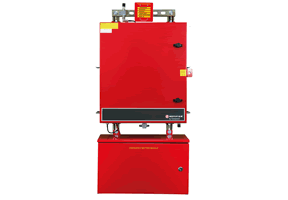
Reliable Two-Way Emergency Radio Communication
Notifier’s Bi-Directional Amplifier System (BDA) is an Emergency Radio Communication Enhancement System (ERCES) which boosts the radio frequency (RF) of emergency responders’ portable radios to eliminate dead spots inside buildings. According to a 2017 survey by the International Association of Fire Chiefs, 98.5% of first responders report dead spots inside buildings and 56% report in-building communications failure during emergencies, as reported in this Notifier® radio communications 2019: Notifier® by Honeywell Bi-Directional Amplifier (BDA) Solutions Reliable Two-Way Emergency Radio Communication .pdf download.
Building construction, size, metal, concrete and construction features can block radio signal, thus hindering life-saving rescue.
Notifier® BDA Meets ERCES Code Compliance
Emergency Radio Communication Enhancement System (ERCES) code requirements were first introduced with the International Building Code, IBC, in 2009. Today, IBC 2015 Section 916 states that emergency responder radio coverage shall be provided in all new buildings, in accordance with International Fire Code, IFC 2018 Section 510. In addition, NFPA 72 2010 and NFPA 1221 also require all buildings to have an approved level of radio coverage within buildings based on the existing coverage levels of the public safety communication systems of the jurisdiction at the exterior of the building.
Code compliance to regulations can be achieved by enhancing the RF signal in buildings with the Notifier® BDA signal booster and distributed antenna system (DAS). Notifier provides the quality and reliability expected from life safety systems with UL2524 product performance, ensuring building owners and AHJs of code compliant ERCES for in-building 2-way emergency radio communications.
Notifier provides a Codes and Reference Guide regarding NFPA, IFC and UL2524 guidelines.
Notifier® BDA Features and Benefits
High Rise Security Systems with SMG Security Holdings offers all Notifier® components required for code compliant ERCES including Notifier® BDA, signal boosters, batteries and enclosures, Distributed Antenna Systems, donor antennas, coaxial cables, connectors and lighting solutions. Notifier® by Honeywell BDAs have been designed to meet all public safety frequency band ranges, providing reliable two-way radio and FirstNet™ signal coverage in various structures, inside buildings and tunnels.
Notifier® by Honeywell BDA provides mission critical communication, with ease of use and deployment, no field tuning or programming required. Notifier® BDAs directly integrate with Notifier fire alarm control panels, provide high reliability with low power consumption and many additional features and benefits:
- Support for all public safety frequency bands:
- UHF: NF-BDA400-1B, NF-BDA400-2B
- VHF: NF-BDA150-1B
- 800 MHz: NF-BDA800-1B
- 700 MHz: NF-BDA700-1B
- 700MHz and 800MHz: NF-BDA7800-2B
- Built-In NOTIFIER Addressable Monitor Module
- Supports higher system gain for efficient link budgeting
- Integrated dual power supply and battery charger with intelligent battery monitoring
- Oscillation Detection Circuit prevents amplifier feedback and oscillations
- Two high-efficiency power supplies are included for redundancy
- Each module has an internal microcontroller that continuously monitors its operation and measures the voltage, temperature, current and other parameters
- Does not require external DC power supplies, chargers or alarm interfaces or feeds
- Ability to connect to NOTIFIER’s SLC loop for monitoring of the BDA at the FACP
- Dedicated supervised Annunciator to provide status on AC power, antenna, charger and low battery. Annunciator mounts in a standard electrical 2-gang box
- On board Diagnostics, graphical LCD displays the BDA and PSU status and trouble conditions along with basic system diagnostics
Notifier’s BDA provides these many features and more, including automatic uplink squelch which eliminates uplink noise to prevent interruption of the public safety radio network when idle.
Contact HRSS/SMG to learn more about the Notifier® BDA and how you can ensure total code compliance with your Emergency Radio Communication Enhancement System (ERCES).


